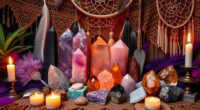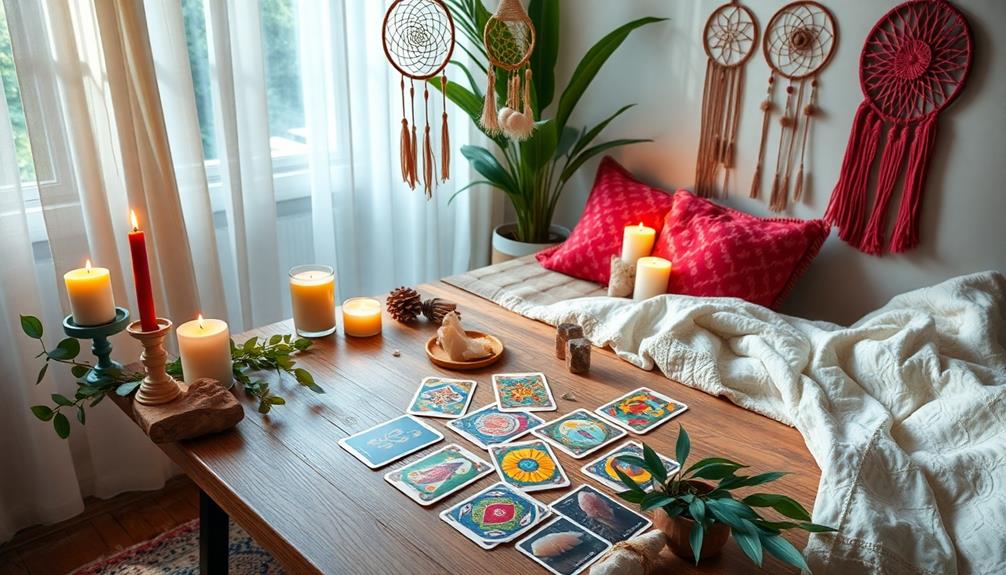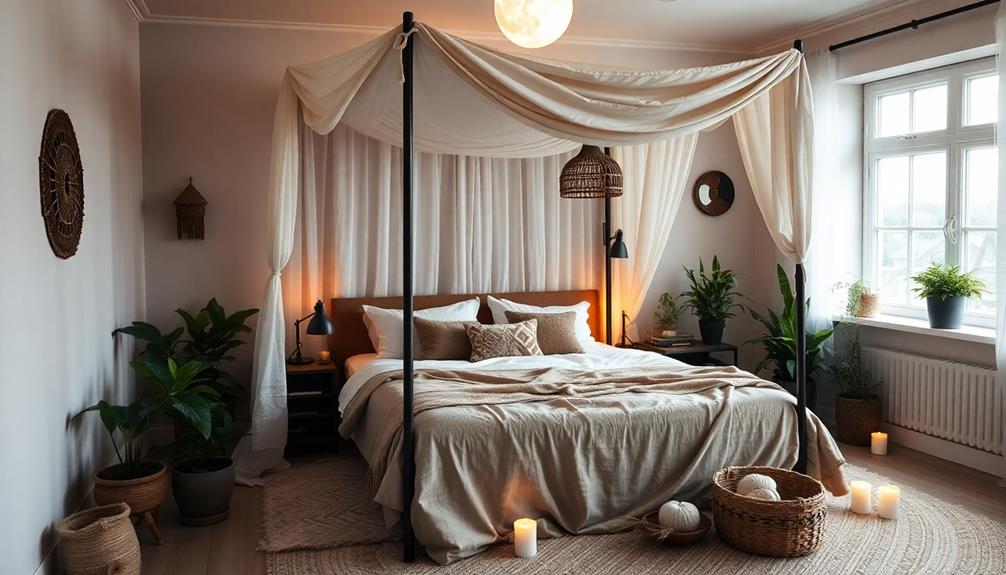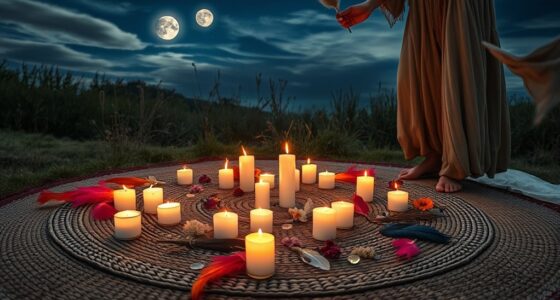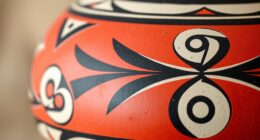To create a cozy boho meditation space, combine vibrant textiles, vintage decor, and natural materials like rattan, jute, and macrame. Layer colorful rugs, cushions, and poufs for comfort, while greenery and hanging plants boost relaxation. Use string lights and eclectic art to set a calm, inviting mood. Balance lively colors with a clutter-free setting to support mindfulness. Keep exploring further to discover tips on designing your perfect sanctuary.
Key Takeaways
- Incorporate eclectic decor with vintage pieces, global textiles, and vibrant boho colors for a relaxed, inviting atmosphere.
- Layer natural textures like rattan, jute, and macrame to evoke serenity and tactile engagement.
- Use lush greenery and natural materials to connect with nature and promote mindfulness.
- Add soft lighting such as string lights and wall art with spiritual or nature motifs to enhance ambiance.
- Maintain a clutter-free space with layered textiles and thoughtful decor to foster mental clarity and relaxation.
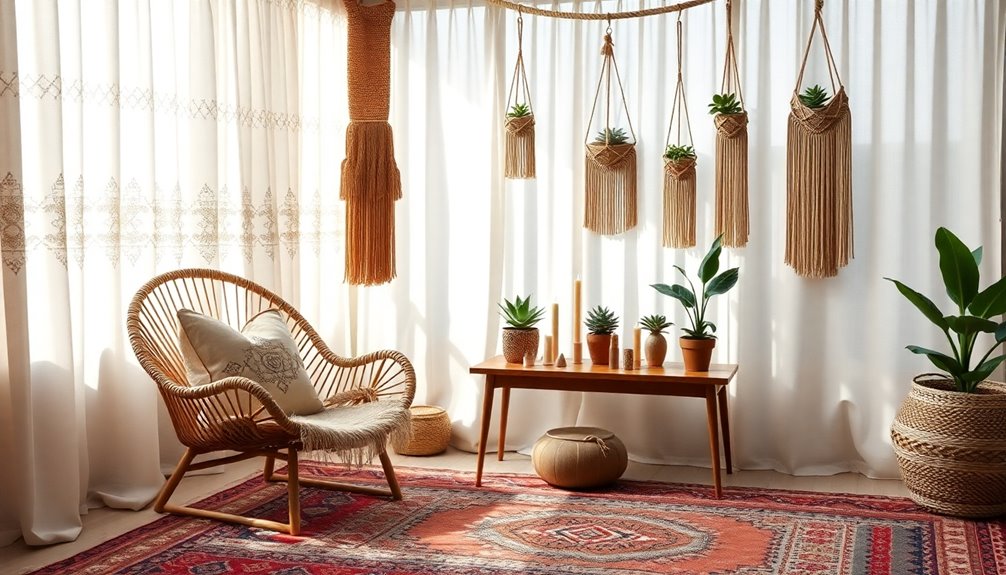
If you’re looking to create a calming and inspiring space for meditation, a boho-inspired design offers the perfect blend of relaxation and artistic expression. Boho spaces celebrate individuality through eclectic decor, mixing vintage pieces with global-inspired textiles and natural elements.
Create a tranquil, artistic meditation space with eclectic decor, natural textures, and vibrant boho colors.
When designing your meditation area, focus on layering textures and colors that evoke a sense of serenity and creativity. Incorporate natural materials like rattan, jute, and macrame to foster a grounded, earthy atmosphere that encourages mindfulness and inner peace. These elements not only add visual warmth but also connect you to nature, making your space feel more inviting and authentic.
Vibrant colors are a hallmark of bohemian style, so don’t hesitate to use earthy tones like terracotta, mustard, deep blues, and muted neutrals. These hues work together to create a relaxed, yet lively environment that stimulates the senses without overwhelming them.
To enhance the cozy vibe, layer rugs, cushions, and poufs—these not only provide comfort but also add richness and depth to the space. The tactile quality of these textiles invites you to settle in and deepen your meditation practice, fostering relaxation and mindfulness.
Wall art plays a fundamental role in setting the mood of a boho meditation room. Choose pieces with spiritual or nature motifs that resonate with your personal journey. Hanging planters filled with lush greenery, string lights that cast a gentle glow, and eclectic decor elements like vintage mirrors or handcrafted wall hangings contribute to the free-spirited, artistic vibe.
These touches reflect your personality and inspire creativity, helping you feel more connected to your practice and environment. A key aspect of bohemian meditation spaces is maintaining a clutter-free but richly textured aesthetic.
This balance allows your mind to relax without distraction while still enjoying visual interest. Keep surfaces clear, but let textures and colors be your guide in creating a space that feels alive and inspiring.
Additionally, incorporating essential techniques such as layering textures and selecting meaningful decor can enhance both the aesthetic and spiritual qualities of your space. The goal is to craft a sanctuary where every element encourages serenity, self-expression, and mindfulness. With natural elements, vibrant colors, wall art, and eclectic decor, your boho meditation space becomes a personal retreat—an oasis of calm that nurtures your soul and awakens your artistic spirit.
Frequently Asked Questions
How to Create a Zen Meditation Room?
To create a zen meditation room, choose a quiet spot with good airflow and minimal distractions.
Keep it simple with essentials like cushions and calming decor.
Add natural elements such as plants, stones, or wood accents to promote peace.
Incorporate soft lighting, like candles or fairy lights, and use textured textiles for comfort.
Personalize your space with meaningful items that inspire tranquility and help you relax deeply during meditation.
What Makes a Good Meditation Space?
Ever wondered what makes a good meditation space? You want a place that’s quiet, clutter-free, and free of distractions, so you can focus and relax.
Incorporate natural elements like plants and crystals, use calming colors, and add comfy cushions and textiles for comfort.
Personal touches, like meaningful artwork or symbols, deepen your connection.
Isn’t it about creating a sanctuary that invites mindfulness and peace every time you meditate?
How to Decorate a Meditation Area?
When decorating a meditation area, you should focus on creating a calming, inviting environment. Use natural elements like crystals, rocks, or greenery to bring in earthy vibes.
Add vibrant textiles such as patterned rugs and cushions for visual interest. Hang macrame, dream catchers, or tapestries to add texture.
Incorporate warm lighting with candles or fairy lights. Personal touches like handmade crafts or meaningful symbols will make the space truly your own.
What Is a Good Color for a Meditation Room?
You might worry that choosing the perfect color could be overwhelming, but remember, calm is key. Soft, muted tones like beige, light gray, or pastel shades create a peaceful atmosphere that helps you relax.
Earth tones like terracotta or olive green ground you in nature, while cool hues like gentle blues enhance tranquility. Avoid bright or neon colors—they can disrupt your focus and make relaxation harder to achieve.
Conclusion
So, you’ve now got the scoop on creating your perfect boho meditation space. Who knew that a sprinkle of fairy lights, a dash of dreamcatchers, and a cozy cushion could turn your room into a zen paradise? Just remember, if your space looks more boho chaos than calm, maybe it’s time for a quick rearrange—or a deep breath. Either way, meditate on it, and let the good vibes roll. Namaste, or whatever.


